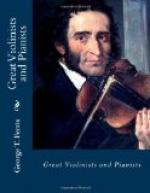Viotti had never received a more genuine compliment, and he did not hesitate to give the old man two pieces of gold instead of one, and then immediately retired from the spot, passing through the crowd with the tin-plate instrument under his arm. He had scarcely gone forty yards when he felt some one pulling at his sleeve; it was a workman, who politely took off his cap, and said:
“Sir, you have paid too dear for that violin; and if you are an amateur, as it was I who made it, I can supply you with as many as you like at six francs each.”
This was Eustache; he had just come in time to hear the conclusion of the bargain, and, little dreaming that he was so clever a violin-maker, wished to continue a trade that had begun so successfully. However, Viotti was quite satisfied with the one sample he had bought. He never parted with that instrument; and, when the effects of Viotti were sold in London after his death, though the tin fiddle only brought a few shillings, an amateur of curiosities sought out the purchaser, and offered him a large sum if he could explain how the strange instrument came into the possession of the great violinist.
After resigning his position as director of the Grand Opera, Viotti returned to London, which had become a second home to him, and spent his remaining days there. He died on the 24th of March, 1824.
V.
Viotti established and settled for ever the fundamental principles of violin-playing. He did not attain the marvelous skill of technique, the varied subtile and dazzling effects, with which his successor, Paganini, was to amaze the world, but, from the accounts transmitted to us, his performance must have been characterized by great nobility, breadth, and beauty of tone, united with a fire and agility unknown before his time. Viotti was one of the first to use the Tourte bow, that indispensable adjunct to the perfect manipulation of the violin. The value of this advantage over his predecessors cannot be too highly estimated.
The bows used before the time of Francois Tourte, who lived in the latter years of the last century in Paris, were of imperfect shape and make. The Tourte model leaves nothing to be desired in all the qualities required to enable the player to follow out every conceivable manner of tone and movement—lightness, firmness, and elasticity. Tartini had made the stick of his bow elastic, an innovation from the time of Corelli, and had thus attained a certain flexibility and brilliancy in his bowing superior to his predecessors. But the full development of all the powers of the violin, or the practice of what we now call virtuosoism on this instrument, was only possible with the modern bow as designed by Tourte, of Paris. The thin, bent, elastic stick of the bow, with its greater length of sweep, gives the modern player incalculable advantages over those of an earlier age, enabling him to follow




